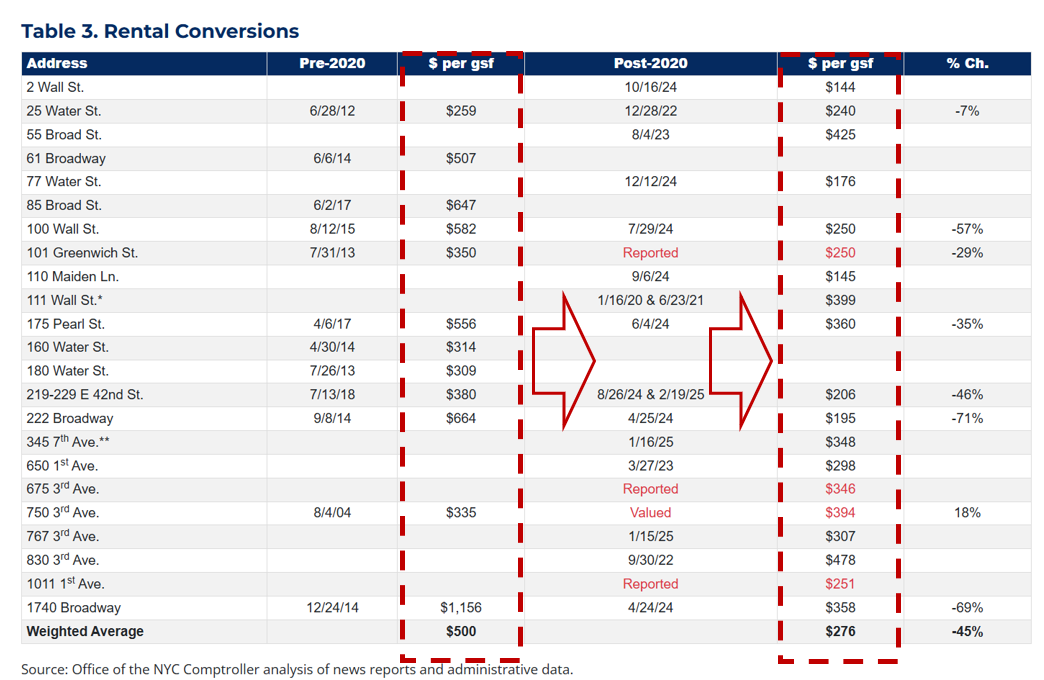Office Conversions and Ground Up Development
The Real Estate Board of NY (REBNY)’s Q2 2025 Construction Pipeline Report highlights the strength of ground-up multifamily activity in NYC. The report illustrated that developers filed for 158 new buildings and 6,943 units, reflecting a 58% increase over the 17-year average. When annualized, that looks like ~600 new buildings containing ~28,000 new apartments in a year. Office to residential conversions are happening in NYC, but at a slower pace. The total pipeline for commercial to residential conversions since Covid-19 is just 17,400 units, across 44 buildings, according to the Office of The Comptroller. More development is expected on all fronts, as rezonings like the Midtown South Mixed-Use Plan (MSMX), Long Island City (LIC) Plan, and Atlantic Avenue Mixed-Use Plan (AAMUP) take hold, but the lion’s share will be in ground up construction. In response to these trends, investors may wonder if the preference for ground-up development is driven by developer choice, scarcity of viable conversion opportunities, regulatory challenges, or some combination of the three? Below, I unpack the data, analyze the drivers, and offer a roadmap for capital allocators and owners navigating this evolving market.
Defining an Attractive Conversion Opportunity
To determine if a building qualifies for conversion, certain must-have requirements must be met; without them, the project simply can't proceed under NYC's framework. According to the City of Yes for Housing Opportunity, buildings constructed before 1991 are prime candidates because they can exceed the 12 FAR cap under the Multiple Dwelling Law, allowing for denser residential use without prohibitive zoning restrictions. Small floor plates (ideally under 15,000 square feet) are needed to enable efficient unit layouts with adequate light and air, while high ceilings (at least 9 feet) and multiple exposures (windows on at least two sides) are essential for meeting residential building code standards for ventilation, natural light, and minimum room dimensions, as outlined in the NYC Zoning Resolution (Section 27-00 et seq.) The Wall Street Journal (WSJ) notes that structural elements like column spacing and core placement must align for residential plumbing and electrical rerouting; mismatched designs can render conversions infeasible due to excessive demolition needs.
Once these thresholds are cleared, economic viability comes into play. Savvy investors search for distressed Class B/C office properties with high vacancies that offer heavily discounted acquisition costs (more on this to follow), making them attractive for repurposing. Tax incentives like the 467-m abatement, which offer up to 90% property tax exemptions for 30 years with 25% affordable units at 80% Area Median Income (AMI), reduce effective costs, enabling positive cash flows where ground-up projects might not pencil out due to land prices. Conversions also bypass some environmental reviews under City of Yes, which can shorten timelines.
Some recent success and future projects include 25 Water Street, a 1,320 units residential rental project, completed in April 2025 as the largest U.S. office to residential conversion. Water street’s transformation of a 1969 office into rentals with 467-m incentives demonstrates the important impacts that can take place when developer convictions and city tax policy are aligned. Upcoming projects include SL Green’s 750 Third Avenue, a prospective 680-unit rental conversion filed in May 2025, 1740 Broadway, Yellowstone’s 422-unit plan, acquired in April 2025 for $186M, and 101 Franklin Street, an office-to-condo conversion acquired in June 2024 for $96.5m.
Challenges for Residential Conversions
Despite their attention-grabbing headlines, office-to-residential conversions present important challenges. One of the major obstacles is that buildings being converted must adhere to NYC compliance measures. NYC’s Zoning Resolution frequently prohibits or restricts residential uses in commercial or manufacturing districts, requiring special permits or variances that add months to approvals—think M1 zones in areas like LIC or AAMUP, where only 10-20% of buildings even qualify for rezoning tweaks under City of Yes. Building codes pose another barrier, requiring compliance with residential standards like enhanced fire safety, natural light requirements (e.g., minimum window areas per the Multiple Dwelling Law), and structural adaptations for plumbing/electrical rerouting, which can render up to 80% of office stock infeasible due to deep floor plates or low ceilings, as noted by the Wall Street Journal WSJ (which referenced Yardi’s Feasibility Index).
Finding the right projects is also difficult because sellers are not willing to sell at the pricing that allows buyers to make profitable conversions. Most office owners cannot take the write-downs in value that are required to make the numbers pencil for the would-be converters. The Office of the Comptroller has done some detailed studies illustrating the financial dynamics of conversions. Recent examples, such as those at 25 Water Street and 750 Third Avenue, highlight successful transactions that have occurred. These examples showcase the significant discounts to pre-COVID valuations that sellers had to accept.

The key takeaway from the Comptroller data is that “…The post-pandemic price is $276 per gross square foot, 45% lower than before 2020,” and interestingly “…On average, office buildings that convert to residential condominium [sic] trade at more than twice the price of rental conversions ($591 vs. $276 per gsf).” But the critical point is that office buildings require value discounts equal to roughly half of their pre-pandemic valuations to be viable candidates for sales and conversions. That means somewhere, someone’s equity is getting wiped out to make room for these trades. It also means most property owners do not want to walk a slow path to vacancy and see their cashflows fall meaningfully until they can perhaps execute a sale.

Finally, related to the pricing challenge that buyers face is the issue of scarcity. The zoning resolution, prior to December 5th, 2024, limited the conversion of office buildings to just those properties built prior to 1961, or 1977 in lower Manhattan. This made the total addressable market of opportunity fairly small for developers. When there aren’t many opportunities and most sellers are inflexible on selling, fewer conversion deals happen
Taken together, the data around permits filed reflect three important realities:
Zoning and building code compliance measures limit the feasibility of potential conversions
The economics of office-to-residential conversions are very challenging – namely, they require sellers to offer big discounts and to create a path to vacancy
The opportunity set is artificially small because not all properties are eligible
COY, MSMX’s, AAMUP’s, and LIC’s Rezoning
The recent zoning policy changes in NYC will spur more housing, as evidenced by new building applications that use additional Universal Affordability Preference (UAP) Floor to Area Ratio (FAR), the slew of purchases in rezoned, or soon-to-be rezoned areas, and the filing of permits for office to residential conversion. The universe of opportunities continues to favor ground up development.
Developers choose ground-up projects because they are more straightforward than commercial conversions. Ground up construction offers design flexibility, allowing tailored unit mixes and amenities that command higher rents. In LIC’s and AAMUP’s M districts, ground-up enables high-density residential builds with luxury amenity packages (that I’ve written about here), leveraging 485-x abatements. MSMX’s newly mapped R11 and R12 districts (15-18 FAR) support ground-up on underbuilt lots in Midtown and West Chelsea neighborhoods.
MSMX expanded the potential for office-to-residential conversions by rezoning a 42 block, 141-acre area in Manhattan to allow for residential (with estimates that 9,500 new apartments could be created). On the other hand, LIC and AAMUP’s rezonings favor the ground up projects since the largely industrial areas limit the potential for true commercial to residential conversions using the 467-m. It will be interesting to see if the ratio of ground up to conversion changes meaningfully in the next few years.
For now though, ground-up development is more popular than commercial to residential conversion due to its ability to provide better renter experiences (e.g., open layouts better light and air), its lighter compliance hurdles (no expensive retrofitting needed), and for the sheer fact that there are more opportunities that lend themselves to ground up development. Yet, investors like conversion opportunities, with firms like Vanbarton Group and SL Green acquiring $100M+ assets (1011 1st Ave and 750 3rd ave) for repurposing, drawn to 467-m incentives amid 22.5% vacancy rates in Manhattans office sector. Capital allocators should understand both opportunities, and the tax abatements that drive much of the value behind them.
*Market Map below on developers!*
If you’re considering whether to do ground up construction or to file for conversions, reach out to Sinclair Realty Group via email at rs@sinclairrealtyco.com for guidance on how this impacts value.
I am bullish on NYC multifamily.
Best Regards,
Romain Sinclair
646 326 2220
Sources
REBNY. (2025). Q2 2025 construction pipeline report. https://www.rebny.com/reports/q2-2025-construction-pipeline-report/
CoStar. (2025). US office leasing comeback expands beyond New York. https://www.costar.com/article/1634292958/us-office-leasing-comeback-expands-beyond-new-york
The Wall Street Journal. (2025). Office-to-apartment conversions real estate 2025. https://www.wsj.com/articles/office-to-apartment-conversions-real-estate-2025
New York City Comptroller. (2025). Office-to-residential conversions in NYC: Economics and fiscal estimates. https://comptroller.nyc.gov/reports/office-to-residential-conversions-in-nyc-economics-and-fiscal-estimates/
BRE. (n.d.). Conversions and demolitions: Reducing US office supply. https://www.cbre.com/insights/briefs/conversions-and-demolitions-reducing-us-office-supply
The Real Deal. (2025). NYC City Council approves Atlantic Avenue rezoning. https://therealdeal.com/new-york/2025/05/28/nyc-city-council-approves-atlantic-avenue-rezoning/
Market Map Below of Active Developers
Keep reading with a 7-day free trial
Subscribe to Romain Sinclair's NY Multifamily Newsletter to keep reading this post and get 7 days of free access to the full post archives.

